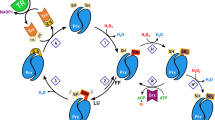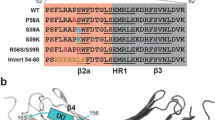Abstract
The molecular fate of thyroglobulin (Tg) is controlled by oligomerization, a means of storing Tg at high concentrations, and deoligomerization. The oligomerization of bovine Tg are intermolecular reactions that occur through oxidative processes, such as disulfide and dityrosine formation, as well as isopeptide formation; disulfide formation is primarily responsible for Tg oligomerization. Here, the protein disulfide isomerase (PDI) and/or peroxidase-induced oligomerization of unfolded thyroglobulins, which were prepared by treating bovine Tg with heat, urea or thiol/urea, was investigated using SDS-PAGE analyses. In addition, the enzymatic oligomerization was compared with non-enzymatic oligomerization. The thermally-induced oligomerization of Tg, dependent on glutathione redox state, was affected by the ionic strength or the presence of a surfactant. Meanwhile, PDI-catalyzed oligomerization, time and pH-dependent, was the most remarkable with unfolded/reduced Tg, which was prepared from a treatment with urea/DTT, while the thermally-unfolded Tg was less sensitive. Similarly, the oligomerization of unfolded/reduced Tg was also mediated by peroxidase. However, PDI showed no remarkable effect on the peroxidase-mediated oligomerization of either the unfolded or unfolded/reduced Tg. Additionally, the reductive deoligomerization of oligomeric Tg was exerted by PDI in an excessively reducing state. Based on these results, it is proposed that PDI catalyzes the oligomerization of Tg through the disulfide linkage and its deoligomerization in the molecular fate, and this process may require a specific molecular form of Tg, optimally unfolded/reduced, in a proper redox state.
Similar content being viewed by others
References
Berndorfer, U., Wilms, H., and Herzog, V., Multimerizatuion of thyreoglobulin during extracellular storage: Isolation of highly cross-linked Tg from human thyroids.J. Clin. Endocrinol. Metabol., 81, 1918–1926 (1996).
Chemoff, S. B., and Rawitch, A. B., Thyroglobulin structure-function: Isolation and characterization of a thyroxine-containing polypeptide from bovine thyroglobulin.J. Biol. Chem., 256, 9425–9430 (1981).
Delom, F., Lejeune, P.-J., Vinet, L., Carayon, P., and Mallet, B., Involvement of oxidative reactions and extracellular protein chaperons in the rescue of misassembled thyroglobulin in the follicular lumen.Biochem. Biophys. Res. Comm., 255, 438–443 (1999).
Delom, R., Mallet, B., Carayon, P., and Lejeune, P. J., Role of extracellular molecular chaperones in the folding of oxidized proteins. Refolding of colloidal thyroglobulin by protein disulfide isomerase and immunoglobulin heavy chain-binding protein.J. Biol. Chem., 276, 21337–21342 (1999).
Frand, A. R., and Kaiser, C. A., Ero1p oxidizes protein disulfide isomerase in a pathway for disulfide bond formation in the endoplasmic reticulum.Mol. Cell., 4, 469–477 (1999).
Freedman, R. B., Hawkins, H. C., and McLaughlin, S. H., Protein disulfide isomerase.Method. Enzymol., 251, 397–406 (1995).
Gentile, F., Pasquale, F., Mamone, G., Malorni, A., and Salvatore, G., Identification of hormonogenic tyrosines in fragment 1218-1591 of bovine thyroglobulin by mass spectrometry.J. Biol. Chem., 272, 639–646 (1997).
Kim, P. S., and Arvan, P., Rolding and assembly of newly synthesized thyroglobulin occurs in a pre-Golgi compartment.J. Biol. Chem., 266, 12412–12418 (1991).
Kim, P. S., Bole, D., and Arvan, P., Transient aggregation of nascent thyroglobulin in the endoplasmic reticulum: relation to the molecular chaperone, BiP.J. Cell Biol., 118, 541–549 (1992).
Kim, P. S., Kim, K-R., and Arvan, P., Disulfide-linked aggregation of thyroglobulin normally occurs during nascent protein folding.Am. J. Physiol., 265, C704-C711 (1993).
Klein, M., Gestmann, I., Bemdorfer, U., Schmitz, A., and Herzog, V., The thioredoxin boxes of thyroglobulin: possible implications for intermolecular disulfide bond formation in the follicle lumen.J. Biol. Chem., 381, 593–601 (2000).
Laemmli, U. K., Cleavage of structural proteins during the assembly of the head of bacteriophage T4.Nature, 227, 680–685 (1970).
Lee, H.-J., and Sok, D. E., Cu2+-catalyzed oxidative degradation of thyroglobulin.Free Radic. Res., 33, 359–368 (2000).
Muresan, Z., and Arvan, P., Enhanced binding to the molecular chaperone BiP slows thyroglobulin export from the endoplasmic reticulum.Mol. Endocrinol., 12, 458–467 (1998).
Saber-Lichtenberg, Y., Brix, K., Schmitz, A., Heuser, J. E., Wilson, J. H., Lorand, L., and Herzog, V., Covalent cross-linking of secreted bovine thyroglobulin by transglutaminase.FASEB J., 14, 1005–1014 (2000).
Sok D.-E., and Sih, C. J., Difference in susceptibility of tyrosine residue to oxidative iodination between a thioredoxin box region and a hormonogenic region.Arch. Pharm. Res., 24, 446–454 (2001).
Tu, B. P., Ho-Schleyer, S. C., Trvers, K. J., and Weissman, J. S., Biochemical basis of oxidative protein folding in the endoplasmic reticulum.Science, 290, 1571–1574 (2000).
Veneziani, B. M., Giallauria, F., and Gentile, F., The disulfide bond pattern between fragments obtained by the limited proteolysis of bovine thyroglobulin.Biochimie, 81, 517–525 (1999).
Venkatesh, S.G., and Deshpande, V., A comparative review of the structure and biosynthesis of thyroglobulin.Comp. Biochem. Physiol., 122, 13–20 (1999).
Author information
Authors and Affiliations
Corresponding author
Rights and permissions
About this article
Cite this article
Liu, XW., Sok, DE. Role of protein disulfide isomerase in molecular fate of thyroglobulin and its regulation by endogenous oxidants and reductants. Arch Pharm Res 25, 485–492 (2002). https://doi.org/10.1007/BF02976607
Received:
Issue Date:
DOI: https://doi.org/10.1007/BF02976607




